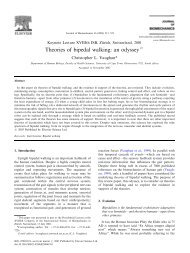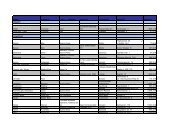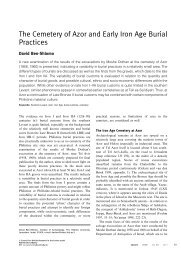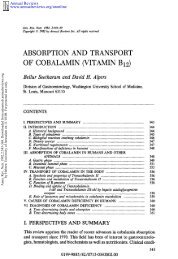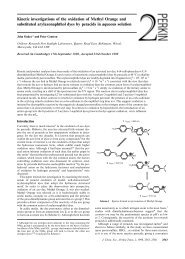The Riddle of Ramat Raḥel: The Archaeology of a Royal Persian ...
The Riddle of Ramat Raḥel: The Archaeology of a Royal Persian ...
The Riddle of Ramat Raḥel: The Archaeology of a Royal Persian ...
Create successful ePaper yourself
Turn your PDF publications into a flip-book with our unique Google optimized e-Paper software.
11<strong>Raḥel</strong> in the <strong>Persian</strong> period. In order to determine the time frame in which the palace <strong>of</strong> buildingphase II existed―from its construction until its ruin, or when it went out <strong>of</strong> use―we must utilize,on the one hand, datable finds unearthed in the foundations <strong>of</strong> the buildings, and on the other,finds above the floors <strong>of</strong> the buildings. As described above, beneath the floors <strong>of</strong> the rooms, andespecially within the fill beneath the courtyards, we found an abundance <strong>of</strong> pottery sherds,figurines, jar handles with stamp impressions, most <strong>of</strong> them from assemblages common to the late8th and the early 7th centuries BCE. In relation to this it is also important to point out what wasnot found in these assemblages. <strong>The</strong>re were no rosette stamp impressions, that didn't come intocirculation before the last third <strong>of</strong> the 7th century BCE (Koch and Lipschits 2010). This is aparticularly obvious and significant fact that enables us to narrow the time frame for theconstruction <strong>of</strong> the second building phase and determine that construction began not later than theearly last third <strong>of</strong> the 7th century BCE. As for the transition between the second and third phases,Aharoni attributed the end <strong>of</strong> his Strata Va (building phase II in the new terminology, and seeLipschits et al. 2011) to the Babylonian occupation <strong>of</strong> 587/6 BCE. He based this assumption onwhat he called a destruction layer found in two locations:1. Room 477 with abundant pottery vessels which he understood to be laying on the floor <strong>of</strong> theroom (Aharoni 1964: 29-32).2. An ash layer resting on the pavement <strong>of</strong> the inner gate (Aharoni 1964: 27).Our reexaminations <strong>of</strong> Aharoni's field records have shown that the pottery assemblage <strong>of</strong>Room 477 was not on the floor <strong>of</strong> the room but beneath it and is actually a favisa (Lipschits andGadot, forthcoming). At the same time, the paving <strong>of</strong> the gate and the fire above it belong to theLate Hellenistic or Early Roman period (ibid.). Apparently there is no evidence that the edifice <strong>of</strong>phase II was destroyed and in contrast to Aharoni's hypothesis, it seems that the continued use <strong>of</strong>the edifice rooms during the <strong>Persian</strong> period, expansion <strong>of</strong> the western sector in building phase IIIand the continued function <strong>of</strong> the central courtyard are evidence that there was no destruction. Amore accurate determination <strong>of</strong> the date <strong>of</strong> abandonment or destruction <strong>of</strong> the complex needs to bebased on the time <strong>of</strong> construction and abandonment <strong>of</strong> the next phase and on the degree <strong>of</strong>architectural continuity between the two phases.Building Phase III: <strong>The</strong> <strong>Persian</strong> Period<strong>The</strong> main addition in building phase III was a large and sturdy new structure. Rectangular inshape, it was built on the northwestern side <strong>of</strong> the second phase <strong>of</strong> the palace complex. Its walls



